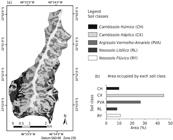ABSTRACT
Digital soil mapping (DSM) permits continuous mapping soil types and properties through raster formats considering variation within soil class, in contrast to the traditional mapping that only considers spatial variation of soils at the boundaries of delineated polygons. The objective of this study was to compare the performance of SoLIM (Soil Land Inference Model) for two sets of environmental variables on digital mapping of saturated hydraulic conductivity and solum depth (A + B horizons) and to apply the best model on runoff risk evaluation. The study was done in the Posses watershed, MG, Brazil, and SoLIM was applied for the following sets of co-variables: 1) terrain attributes (AT): slope, plan curvature, elevation and topographic wetness index. 2) Geomorphons and terrain attributes (GEOM): slope, plan curvature, elevation and topographic wetness index combined with geomorphons. The most precise methodology was applied to predict runoff areas risk through the Wetness Index based on contribution area, solum depth, and saturated hydraulic conductivity. GEOM was the best set of co-variables for both properties, so this was the DSM model used to predict the runoff risk. The runoff risk showed that the critical months are from November to March. The new way to classify the landscape to use on DSM was demonstrated to be an efficient tool with which to model process that occurs on watersheds and can be used to forecast the runoff risk.
geomorphons; terrain attributes; saturated hydraulic conductivity; solum depth

 Thumbnail
Thumbnail
 Thumbnail
Thumbnail
 Thumbnail
Thumbnail
 Thumbnail
Thumbnail
 Thumbnail
Thumbnail
 Thumbnail
Thumbnail
 Thumbnail
Thumbnail
 Thumbnail
Thumbnail
 Thumbnail
Thumbnail
 Thumbnail
Thumbnail









